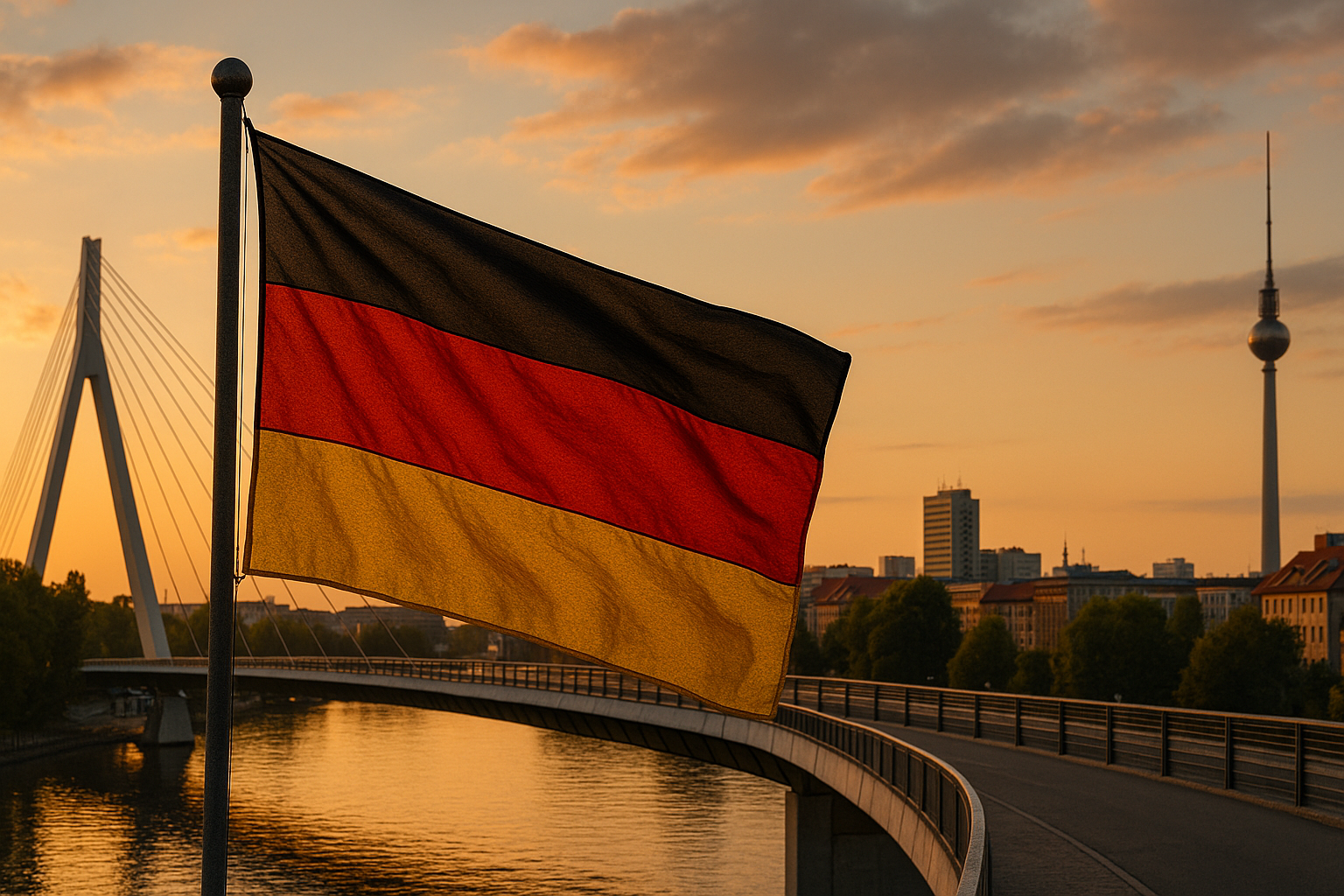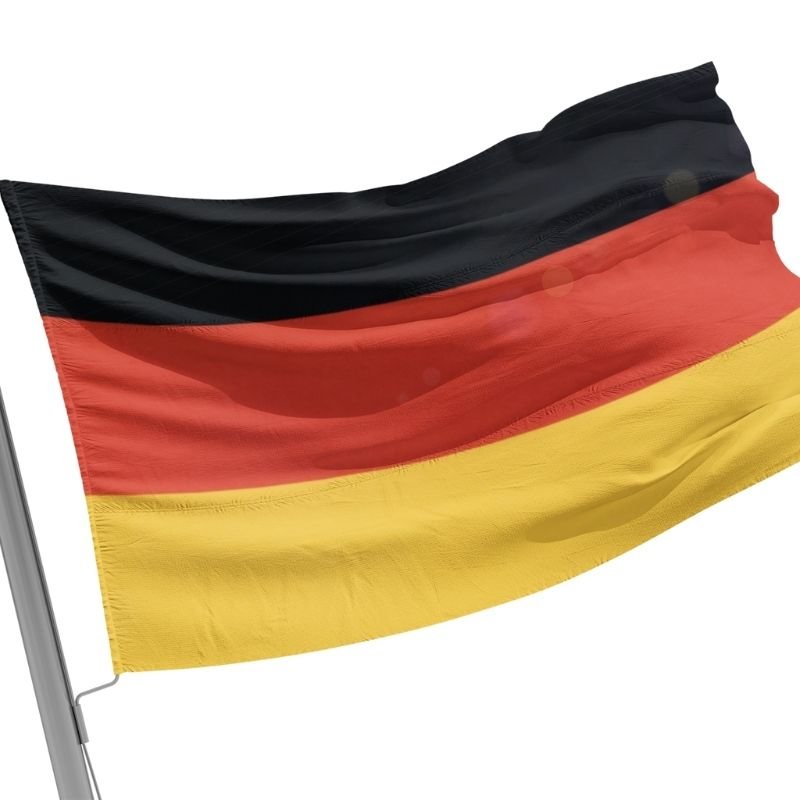
Germany Flag: Colors, Meaning, History, Origin
The black, red, and gold horizontal tricolor that represents Germany today stands as a powerful emblem of national identity, democratic values, and historical resilience. This distinctive flag has witnessed the complex transformation of German statehood through centuries of political turbulence, revolution, division, and ultimately, reunification. Unlike many national flags with relatively straightforward histories, Germany’s tricolor reflects a nation’s challenging journey toward democracy and unity, making it not merely a national symbol but a visual chronicle of German political evolution.
Quick Summary
The German flag featuring horizontal bands of black, red, and gold stands as a powerful symbol of Germany’s complex political journey. Its origins trace back to early 19th century student movements that emerged after the Napoleonic Wars, seeking German unity and liberal reforms against fragmented principalities.
The colors gained revolutionary significance during the 1848 democratic uprisings when the Frankfurt Parliament adopted them as Germany’s first national flag. Bismarck’s German Empire rejected these democratic colors, instead establishing black, white, and red as imperial colors representing Prussian dominance.
After World War I, the Weimar Republic restored the black, red, and gold tricolor as Germany embraced democracy. This democratic symbol was subsequently banned by the Nazi regime, which imposed the swastika flag as the sole national emblem from 1935 to 1945.
The post-war division of Germany created a unique situation where both East and West claimed the same historic colors. West Germany adopted the simple tricolor while East Germany added a communist emblem to distinguish its flag. This visual division lasted until reunification in 1990.
Today’s German flag represents not geographic features but a political achievement – the triumph of democratic values after centuries of struggle. The colors carry layered meanings accumulated through history: black representing determination, red symbolizing the blood shed for freedom, and gold standing for light and prosperity.
Unlike many national symbols born of victory, Germany’s flag emerged from repeated democratic failures before final success. This history makes it particularly meaningful as the emblem of modern Germany’s commitment to democracy, European integration, and peaceful cooperation within the international community.
Medieval Origins of the German Colors
The Holy Roman Empire Connection
The origins of Germany’s black, red, and gold color combination have long been debated among historians and vexillologists. While commonly linked to the Holy Roman Empire, this connection requires nuanced understanding. The imperial banner indeed featured a black eagle with red claws and beak against a gold background, providing a potential early source for these distinctive colors. However, the deliberate combination of these three colors as a unified national symbol would emerge much later in German history.
Early Uses of These Colors
During the medieval period, these colors appeared separately across various German territories and principalities. The imperial free cities and many regional banners incorporated elements of black and gold, particularly through the imperial eagle motif. Red frequently appeared in heraldic designs of various German noble houses. Though present individually throughout German heraldic tradition, these colors did not constitute a recognized tricolor arrangement or national symbol during this era.
Symbolic Meanings
The symbolic significance assigned to these colors evolved considerably over time. In early heraldic tradition, gold represented nobility, prosperity and imperial authority. Black signified strength and determination, while red commonly symbolized bravery and bloodshed. These meanings transformed as the colors gained political significance in later centuries, but their roots in medieval symbolism provided a foundation for their later adoption as national colors.
The transition from medieval heraldry to modern national symbolism would require profound political change. It wasn’t until the early 19th century, amid growing nationalist sentiment and revolutionary ideals, that these colors would coalesce into a deliberate political symbol. The story of how student fraternities and revolutionary movements adopted these colors marks the beginning of the German flag’s modern history.
For history enthusiasts interested in displaying authentic representations of Germany’s historical flags, including reproductions of medieval imperial banners featuring these original color elements, the Cosmoflag collection offers museum-quality replicas crafted with historical accuracy and premium materials.
Revolutionary Beginnings (1815-1848)
Student Fraternities and Burschenschaften
The deliberate combination of black, red, and gold as a unified political symbol emerged from the patriotic fervor following the Napoleonic Wars. In 1815, German university students, many of whom had fought against Napoleon, formed fraternities called Burschenschaften at the University of Jena. These organizations sought to promote German unity and liberal reforms in an era when “Germany” existed only as a fragmented collection of independent states. The Urburschenschaft, the first such student group, deliberately chose black, red, and gold for their flag.
These colors held specific meaning for the students: black represented the darkness of past oppression, red symbolized the bloodshed in the struggle for freedom, and gold stood for the light of liberty they sought to achieve. The choice also reflected the uniforms of the Lützow Free Corps, a volunteer force that had fought against Napoleon, who wore black uniforms with red trim and gold buttons. This origin firmly linked these colors with early German nationalism and democratic aspirations.
The Hambach Festival of 1832
The black, red, and gold tricolor gained broader political significance during the Hambach Festival of 1832, a pivotal event in early German democratic movements. Approximately 30,000 people gathered at Hambach Castle in the Palatinate region to advocate for political reforms, civil liberties, and German unification. Black, red, and gold banners dominated the event, transforming what had been primarily a student symbol into a widely recognized emblem of liberal German nationalism.
The festival participants proudly displayed these colors as they called for a unified German republic, freedom of speech, and political reforms. This gathering represented one of the first mass political demonstrations in German history, and the tricolor’s prominent role cemented its status as the banner of progressive German nationalism. After Hambach, authorities in many German states banned the display of these colors, recognizing their revolutionary potential.
March Revolution of 1848
The black, red, and gold tricolor reached its revolutionary apex during the tumultuous events of 1848-49. As revolutionary movements swept across Europe, Germans rose in demand of national unity, constitutional governance, and civil liberties. On March 18, 1848, revolutionaries in Berlin hoisted the black, red, and gold flag as their symbol. When the revolution spread, the newly formed Frankfurt Parliament, Germany’s first democratically elected national assembly, officially adopted these colors as the national flag.
This period represented the first time the black, red, and gold tricolor served as an official German national symbol. The flag flew proudly over the Paulskirche in Frankfurt, where delegates debated a constitution for a unified, democratic Germany. Though the revolution ultimately failed when conservative forces regained control in 1849, the association between these colors and German democratic aspirations became indelibly established in national consciousness.
The flags from this revolutionary period represent crucial artifacts in Germany’s democratic heritage. History collectors and enthusiasts interested in this pivotal era can find faithful reproductions of the 1848 revolutionary flag in our Cosmoflag collection, each crafted to honor this important chapter in Germany’s journey toward democracy and unity.
Imperial Era (1871-1918)
The Black, White, and Red Flag
When Otto von Bismarck succeeded in unifying Germany under Prussian leadership in 1871, the newly established German Empire deliberately rejected the black, red, and gold tricolor. This rejection was both political and symbolic. The new imperial government, dominated by conservative Prussian nobility, viewed the democratic tricolor with suspicion due to its association with revolutionary movements. Instead, they adopted a horizontal tricolor of black, white, and red as the national flag of the German Empire.
These colors represented a combination of the black and white of Prussia (the dominant state in the new empire) and the red and white colors of the Hanseatic League cities. This choice emphasized Prussian leadership while acknowledging the northern commercial centers that contributed to German prosperity. The imperial flag thus symbolized a very different vision of German nationhood: one based on monarchical authority, Prussian military prowess, and commercial strength rather than democratic principles.
Competing National Identities
Throughout the imperial period, Germany experienced tension between competing visions of national identity. The official black, white, and red flag represented the conservative, monarchical conception of Germany championed by the ruling elites. However, the black, red, and gold colors never completely disappeared from German political life. Progressive and democratic movements continued to use these colors as a symbol of opposition to authoritarian rule and as a reminder of unfulfilled democratic aspirations.
This period of German history witnessed the institutionalization of national symbols, with the imperial flag appearing on government buildings, warships, and official documents. The government promoted the imperial colors through education, military displays, and public celebrations, working to establish them as the authentic symbol of German nationhood. Yet the persistence of the alternative tricolor reflected deeper divisions within German society about the fundamental nature of the German state.
Symbolism During the First World War
The imperial flag took on heightened significance during World War I (1914-1918). As Germany mobilized for total war, the black, white, and red tricolor became a rallying symbol for national unity and military resolve. The flag appeared on war bonds, propaganda posters, and patriotic memorabilia. Military units carried the imperial colors into battle, and civilians displayed the flag to demonstrate their support for the war effort.
However, as the war dragged on and conditions worsened, the imperial flag increasingly represented a regime that was losing legitimacy. Military setbacks, food shortages, and political repression undermined popular support for the imperial government. By 1918, revolutionary movements again emerged, often carrying the black, red, and gold colors of an alternative German tradition. When the empire collapsed following military defeat, the imperial flag fell with it, creating an opening for the return of the democratic tricolor.
Weimar Republic (1919-1933)
Return to Black, Red, and Gold
Following the collapse of the German Empire and the abdication of Kaiser Wilhelm II in November 1918, Germany entered a period of profound political transformation. The new democratic government, formed amid revolution and civil unrest, sought symbols that would represent a clear break with the imperial past. In this context, the black, red, and gold tricolor reemerged as the national flag, reclaiming its position as the emblem of German democratic aspirations.
This choice deliberately connected the new republic with the democratic traditions of 1848, emphasizing continuity with earlier struggles for liberty and national unity. The Weimar Republic, named after the city where its constitution was drafted, officially adopted the black, red, and gold horizontal tricolor on August 11, 1919. For many Germans, particularly those with progressive political views, this return to the traditional democratic colors represented hope for a new era of constitutional governance and civil liberties.
Constitutional Recognition
The Weimar Constitution explicitly established black, red, and gold as the national colors in Article 3, giving these colors constitutional protection for the first time in German history. The official adoption represented more than aesthetic preference; it signified the republic’s commitment to democratic principles and its attempt to create a new political identity distinct from the authoritarian imperial state.
The government worked to promote the flag through official ceremonies, public education, and diplomatic representation. For the first time, these colors represented Germany internationally, flying over embassies and consulates worldwide. The Weimar period saw the standardization of the flag’s dimensions and color specifications, establishing the precise shade of gold (actually a golden yellow) that continues in the modern German flag.
Political Controversies
Despite its official status, the Weimar flag never achieved universal acceptance among the German population. Many conservatives and nationalists continued to view the imperial black, white, and red as the authentic national colors. Veterans organizations, monarchist groups, and right wing political parties often displayed the imperial flag as a protest against the republic. The German navy and merchant marine continued using ensigns that incorporated elements of the imperial colors, reflecting compromise within the naval establishment.
Far right groups, including the emerging Nazi party, explicitly rejected the republican tricolor, viewing it as a symbol of national humiliation following Germany’s defeat in World War I. They associated the black, red, and gold with what they considered the “November criminals” who had signed the armistice in 1918 and the Treaty of Versailles in 1919. This polarization around national symbols reflected deeper divisions within German society during the Weimar era.
The flag controversies of this period reveal how national symbols can become battlegrounds for competing visions of national identity. As the Weimar Republic faced economic crisis, political extremism, and growing disillusionment during the late 1920s and early 1930s, the status of the national flag increasingly reflected the precarious position of German democracy itself. The black, red, and gold tricolor, though legally established, remained contested throughout this turbulent period of German history.
The Nazi Period (1933-1945)
Abandonment of Black, Red, and Gold
When Adolf Hitler became Chancellor of Germany on January 30, 1933, the fate of the Weimar flag was quickly sealed. The Nazi regime immediately began dismantling democratic institutions and symbols, including the black, red, and gold tricolor that represented republican values. On March 12, 1933, just six weeks after taking power and one day after the March elections, Hitler issued a decree establishing two official national flags: the swastika flag of the Nazi party and the old imperial black, white, and red tricolor.
This dual flag decree represented a transitional phase in the Nazi consolidation of power. By reinstating the imperial colors alongside their party banner, the Nazis appealed to conservative nationalists while preparing for complete ideological control. The black, red, and gold combination was explicitly rejected, with Nazi propaganda portraying these colors as symbols of weakness, democratic decadence, and national betrayal. The display of the Weimar flag became effectively criminalized, with citizens facing potential arrest for showing allegiance to the republican colors.
The Swastika Flag
On September 15, 1935, at the Nazi Party rally in Nuremberg, the regime announced that the swastika flag would become the sole national flag of Germany. This flag featured a black swastika on a white circular background, centered on a red field. The design originated as the party flag of the National Socialist German Workers’ Party (NSDAP) in 1920, created by Hitler himself according to Nazi mythology.
The colors incorporated elements of the imperial flag tradition, with black, white, and red arranged in a new configuration. Nazi ideology assigned specific meaning to these elements: the red represented the social idea of Nazism, the white stood for German nationalist ideology, and the swastika symbolized the mission of the “Aryan race.” The flag became omnipresent throughout German society, displayed on all government buildings, schools, and public spaces. Citizens were expected to display the flag during national holidays and Nazi celebrations, making it the most visible symbol of the totalitarian state.
Suppression of Democratic Symbols
The Nazi regime systematically eliminated all visual references to Germany’s democratic traditions. The black, red, and gold colors disappeared from public life, with possession of such items potentially leading to surveillance, interrogation, or worse. The regime rewrote history textbooks to minimize or denigrate the democratic movements of 1848 and 1918, instead emphasizing a narrative of national destiny that culminated in Nazi rule.
This suppression extended beyond flags to all spheres of public life. The regime replaced democratic state emblems, redesigned currency and postage stamps, and created new national holidays centered on Nazi ideology. The government conducted public book burnings of works deemed incompatible with Nazi ideology, including literature associated with democratic traditions. Through these actions, the regime attempted to erase the visual legacy of German democracy from public consciousness.
The psychological impact of this visual transformation cannot be overstated. Within a remarkably short period, the symbolic landscape of German society shifted completely, reinforcing the Nazi monopoly on power through constant visual reminders of the regime’s authority. When Germany entered World War II in 1939, the swastika flag became associated with military conquest as German forces placed it over occupied territories across Europe.
Post-War Division (1945-1990)
Two German Flags
Following Germany’s defeat in World War II and the collapse of the Nazi regime, the country faced complete political transformation under Allied occupation. The swastika flag was immediately banned, creating a symbolic vacuum in a nation divided into occupation zones. As Cold War tensions intensified, Germany itself split into two separate states: the Federal Republic of Germany (West Germany) in 1949 and the German Democratic Republic (East Germany) shortly thereafter.
Both German states turned to the black, red, and gold tricolor as their national flag, reclaiming these colors from their democratic traditions. This shared choice reflected competing claims to legitimate German statehood and democratic heritage. West Germany adopted the simple horizontal tricolor on May 23, 1949, as part of its Basic Law (constitution). East Germany initially used the same flag but soon sought visual distinction from its western counterpart.
Modifications and Distinctions
In 1959, East Germany modified its flag by adding a coat of arms to the center. This emblem featured a hammer and compass surrounded by a ring of rye, symbolizing the alliance of workers, intelligentsia, and farmers under socialism. The addition transformed what had been identical flags into distinct national symbols, allowing immediate visual identification of East German state property, documents, and diplomatic representations.
West Germany maintained the unadorned tricolor throughout this period, connecting its identity to the democratic traditions of the Weimar Republic and the 1848 revolutionaries. West German authorities considered their version the authentic national flag, viewing the East German modification as ideological appropriation. This position aligned with West Germany’s broader claim to be the sole legitimate representative of the German people, a stance known as the Hallstein Doctrine that dominated West German foreign policy until the early 1970s.
Symbolic Meaning During the Cold War
Throughout the Cold War, the two German flags represented competing visions of German identity and political legitimacy. For West Germany, the unmodified tricolor symbolized commitment to parliamentary democracy, individual liberty, and integration with Western Europe and NATO. The flag flew alongside those of Western allies and European partners, representing West Germany’s position in the democratic bloc.
In East Germany, the modified flag represented socialist internationalism, alignment with the Soviet Union, and what the government described as “real existing socialism.” The state promoted the flag through youth organizations, public celebrations, and extensive propaganda emphasizing the socialist character of East German nationhood. The flag appeared alongside those of other Warsaw Pact countries at official functions, sports competitions, and international events.
For Germans living on either side of the divided nation, these flags became everyday reminders of national division. At international sporting events, the appearance of two German flags visually reinforced the political reality of separation. The flags appeared at border crossings between East and West, symbolizing not just different territories but divergent political systems and ways of life.
As years passed, the modified East German flag became less a symbol of ideological distinction and more simply the familiar national emblem for citizens of the GDR. When Germans from both states encountered each other at international events or rare family visits, the flags represented the tangible reality of a nation divided against the backdrop of global ideological conflict.
Reunification and Modern Era (1990-Present)
Restoration of the United Flag
The fall of the Berlin Wall in November 1989 triggered a rapid sequence of events leading to German reunification. As the East German government collapsed amid peaceful revolution, questions about national symbols gained immediate practical significance. During demonstrations in late 1989 and early 1990, many East German protesters deliberately cut the state emblem from their flags, creating a powerful visual statement rejecting the socialist state while embracing unification under democratic principles.
When formal reunification occurred on October 3, 1990, the unmodified black, red, and gold tricolor became the national flag of united Germany. This choice represented both continuity with West German democratic institutions and reconnection with the shared historical traditions of 1848 and 1919. The decision to maintain the simple tricolor rather than create a new design emphasized that reunification constituted the accession of East German territories to the existing Federal Republic rather than the creation of an entirely new state.
Legal Protection
The united Germany maintained strong legal protections for national symbols established under West German law. The flag received constitutional status through Article 22 of the Basic Law, which explicitly states: “The federal flag is black, red and gold.” German law prohibits the defacement or denigration of national symbols, with specific provisions against their misuse. These protections reflect Germany’s commitment to democratic institutions and awareness of how national symbols had been manipulated during the Nazi period.
Following reunification, Germany also maintained strict prohibitions against Nazi symbols, including the swastika flag. Unlike some countries where free speech protections might permit such displays, German law explicitly criminalizes the public use of symbols from banned organizations. This approach reflects Germany’s commitment to confronting its difficult past rather than allowing potentially dangerous ideologies to reemerge under the guise of historical interest or free expression.
Contemporary Significance
The contemporary German flag holds complex meanings for citizens of the reunified republic. For many Germans, particularly those who lived through division, the tricolor represents the achievement of national unity and the triumph of democratic values after decades of separation. The flag appears prominently during national celebrations, particularly on German Unity Day (October 3) commemorating reunification.
However, Germany’s relationship with national symbols differs notably from many other countries. Due to historical associations with aggressive nationalism, particularly during the Nazi period, Germans have traditionally displayed more restraint in flag use compared to countries like the United States or France. This changed somewhat during the 2006 FIFA World Cup hosted in Germany, when many citizens embraced flag display as an expression of a more relaxed, confident national identity within a unified Europe.
Today, the black, red, and gold tricolor appears prominently on government buildings, at official ceremonies, and during international sporting events. It represents a Germany committed to European integration, democratic values, and international cooperation. The flag symbolizes not just national sovereignty but also Germany’s transformation from divided, war-torn nation to unified democratic state and economic powerhouse within the European Union.
For younger generations born after reunification, the flag increasingly represents a Germany defined by its democratic present rather than its divided past. While maintaining awareness of historical complexities, many contemporary Germans view their national colors as appropriate symbols of a successful, peaceful republic integrated within the broader European community.
Design and Specifications
Official Colors and Proportions
The German flag consists of three equal horizontal bands of black (top), red (middle), and gold (bottom). These colors are precisely defined in the “Corporate Design Manual of the Federal Government” to ensure consistency across all official uses. The exact color specifications are:
Black: RAL 9005 (Jet black)
Red: RAL 3020 (Traffic red)
Gold: RAL 1021 (Rape yellow)
The flag maintains a proportion ratio of 3:5, meaning that for every 3 units of height, the flag extends 5 units in length. This standardization ensures visual consistency whether the flag appears on government buildings, diplomatic missions, or official documents. For official state occasions, the federal service flag (Bundesdienstflagge) incorporates the German coat of arms (the Federal Eagle) centered on the tricolor, though this version is reserved exclusively for federal government use.
Proper Display Guidelines
German law provides specific guidelines for the respectful display of the national flag. When displayed vertically, the black band should appear on the left from the viewer’s perspective. When multiple flags are displayed, specific protocols determine positioning: in bilateral meetings, the German flag typically appears to the right of the guest country’s flag from the viewer’s perspective, while in multilateral settings, flags generally follow alphabetical order according to local language.
On specific commemorative days, flags may be flown at half-mast following government directives, particularly on the annual Day of Remembrance for victims of National Socialism (January 27) and the National Day of Mourning (Volkstrauertag). During such observances, the flag is first raised to the top of the staff, then lowered to the half-mast position.
While Germany lacks the extensive flag code found in countries like the United States, general principles of respect apply. The flag should never touch the ground, should not be used for commercial advertising in ways that might diminish its dignity, and should be disposed of respectfully when worn or damaged beyond repair.
Variants and Related Flags
Several official variants of the German flag exist for specific governmental and military purposes. The federal service flag, featuring the eagle emblem, serves as the governmental standard. The German naval ensign incorporates the national colors with a distinctive cross design and the federal eagle. Military units carry special ceremonial flags (Truppenfahnen) that incorporate the national colors with unit-specific insignia.
Germany’s sixteen federal states (Bundesländer) each maintain their own flags with distinctive designs reflecting regional history and identity. These range from simple bicolor or tricolor designs to more complex emblems incorporating historical coats of arms. State flags fly alongside the national flag on government buildings within each state, visually representing Germany’s federal system of governance.
The German flag has also influenced other national flags throughout history. During the Cold War, several African nations adopted the black, red, and gold color scheme following independence, often reflecting both German influence and local symbolism. The colors appear in the flags of Uganda, Angola, and Belgium, though typically arranged in different patterns and representing distinct national histories.
The standardization of the flag’s design and display reflects Germany’s systematic approach to national symbols, ensuring consistent representation of the republic both domestically and internationally while maintaining connections to the country’s democratic traditions.





